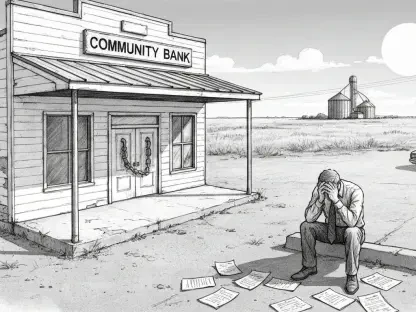In the bustling financial landscape of Dallas, a remarkable story of resilience and reinvention has unfolded at Texas Capital, a regional bank that has risen from the brink of collapse to become a formidable player in the industry. Once burdened by financial underperformance, plummeting stock prices, and the fallout of a failed merger, the bank has staged an extraordinary comeback under the visionary leadership of Rob Holmes, who assumed the roles of chairman, president, and CEO in January 2021. This transformation is not just a tale of numbers but a testament to strategic foresight, cultural renewal, and an unwavering commitment to prioritizing people over mere profit. What makes this journey even more compelling is how Texas Capital leveraged the unique economic vitality of its home state to carve a distinct niche in a volatile sector. The path to becoming a full-service financial institution was fraught with challenges, yet the bank’s recent record-breaking quarterly results signal a profound shift. This narrative explores the key drivers behind this turnaround, delving into the bold strategies, operational changes, and regional advantages that propelled Texas Capital to new heights.
Crafting a Bold Strategic Vision
The foundation of Texas Capital’s revival rests on a meticulously designed strategic plan unveiled by Rob Holmes on September 1, 2021, with ambitious targets set for the coming years. This wasn’t merely a financial blueprint but a comprehensive roadmap to redefine the bank as a full-service financial institution capable of competing with larger national players. Astonishingly, by the third quarter of recent years, nearly all these goals had been achieved, reflecting a dramatic improvement in profitability and operational stability. Revenue diversification played a critical role, with income from investment banking and trading surging from just 2.2% to an impressive 10.3% of total earnings. Additionally, the bank tackled its over-reliance on unstable indexed deposits, reducing their share from 36% to a mere 6%, thus fortifying its financial base against market fluctuations. Metrics like return on average assets also saw a remarkable climb, moving from 0.33% in 2020 to 1.3%, underscoring a newfound resilience that positioned Texas Capital as a standout performer in the regional banking arena.
Beyond the balance sheet, this strategic vision encompassed a broader ambition to de-risk the institution while fostering sustainable growth. Stabilizing deposits was only part of the equation; the bank also focused on building high-quality, repeatable earnings that could withstand economic turbulence. This forward-thinking approach meant not just chasing short-term gains but embedding structural changes that would ensure long-term viability. Holmes’ emphasis on transforming Texas Capital into a diversified financial hub resonated with stakeholders, as evidenced by the bank’s ability to meet its targets ahead of schedule. Such progress highlights how a clear, actionable plan, paired with relentless execution, can turn around even the most beleaguered institutions, setting a benchmark for others in the industry to follow.
Prioritizing People as the Heart of Growth
A pivotal element in Texas Capital’s resurgence lies in its profound commitment to people, encompassing both its workforce and clientele. Recognizing that talent is the backbone of any successful organization, the bank set out to become the “employer of choice” in Texas, a goal that materialized through substantial investments in human capital. Since 2021, a staggering 90% of the staff has been newly hired, bringing fresh perspectives and energy to the institution. Enhanced benefits, including generous parental leave policies and equitable cost-sharing for lower-paid employees, were introduced to attract and retain top talent. A significant $86 million increase in salaries and benefits expenses between 2021 and 2022 further demonstrated this dedication, reflecting a belief that employee satisfaction directly fuels organizational success. Feedback from platforms like Glassdoor, highlighting perks such as 401K matching, paints a picture of a workplace where staff feel valued and motivated.
Equally transformative was the bank’s approach to client relationships, adopting what has been termed a “client obsession” culture. By doubling the number of client-facing roles, Texas Capital shifted its focus from traditional metrics like deposit volumes to building deeper, trust-based connections with customers. This strategy prioritized understanding and meeting client needs over chasing numerical targets, a move that distinguished the bank in a sector often criticized for its transactional nature. The result has been a loyal customer base that views Texas Capital not just as a service provider but as a partner in their financial journey. This dual emphasis on employee well-being and client satisfaction created a virtuous cycle, where motivated staff delivered exceptional service, further strengthening the bank’s reputation and market position.
Redefining Culture and Operations
The transformation at Texas Capital extended far beyond financial metrics, embedding a cultural and operational overhaul that redefined how the bank functions. Under Rob Holmes’ guidance, a culture of accountability and collaboration was instilled through structured routines such as weekly operating council meetings and monthly business reviews. These mechanisms ensured that every level of the organization remained aligned with the overarching mission, fostering a sense of unity and purpose. A notable decision to return to a five-day in-office work policy in mid-2021, at a time when hybrid models were gaining traction, underscored the value placed on in-person interaction. This move was particularly aimed at supporting the professional growth of junior employees, who benefit immensely from direct mentorship and team dynamics, proving that physical presence can still be a powerful tool for building cohesive teams.
Symbolizing this cultural shift is the newly renovated Texas Capital Center in Uptown Dallas, a modern facility equipped with cutting-edge amenities and a dedicated trading floor. More than just a workspace, this center represents an investment in employee morale and pride, often referred to by Holmes as instilling a sense of “swagger” among the staff. The environment encourages productivity and innovation, serving as a tangible reminder of the bank’s commitment to creating a workplace that inspires excellence. This operational and cultural reinvention has not only improved internal efficiency but also enhanced external perceptions, positioning Texas Capital as a forward-thinking institution ready to tackle the challenges of a competitive industry with confidence and clarity.
Leveraging the Unique Texas Edge
Texas Capital’s ascent is inseparable from its deep-rooted connection to Texas, a state increasingly recognized as a financial powerhouse often dubbed “Y’all Street.” The region’s economic dynamism, characterized by low taxes, affordable living costs, and robust growth, provided an ideal backdrop for the bank’s revival. These factors made Texas an attractive destination for top talent, enabling Texas Capital to build a skilled workforce while serving a thriving local business community. As a top lender to Texas-based enterprises, the bank capitalized on this environment to strengthen its market presence, offering tailored solutions that resonated with the state’s entrepreneurial spirit. This localized focus became a cornerstone of its competitive strategy, setting it apart in a crowded field.
What further distinguishes Texas Capital is its ability to blend the intimacy of local decision-making with the sophistication of a money-center platform. Unlike global banks that may lack regional nuance or smaller local players without comprehensive offerings, this hybrid model allowed the bank to deliver personalized service backed by robust financial capabilities. This strategic positioning proved especially advantageous in a regional banking landscape marked by instability, with high-profile failures like Silicon Valley Bank in 2023 shaking industry confidence. Texas Capital’s stock, rising over 11% year-to-date and outperforming the KBW Regional Banking Index, reflects investor trust in its ability to navigate these challenges while harnessing the unique advantages of its home state.
Facing Industry Headwinds with Confidence
The regional banking sector has faced significant turbulence in recent years, with mergers, acquisitions, and outright collapses creating a climate of uncertainty for many institutions. Yet, amidst this backdrop, Texas Capital has emerged as a beacon of stability, with its stock performance outpacing industry benchmarks and signaling strong market confidence. Experts such as William T. Chittenden from SMU have noted that evolving into a full-service provider was not merely a strategic choice but a survival imperative for banks aiming to rank among the top 100 in the U.S. Texas Capital’s success in achieving this transition highlights its adaptability, as it expanded beyond traditional commercial lending into areas like investment banking and treasury management, diversifying its revenue base to weather economic fluctuations.
While the bank’s third-quarter results in recent years marked a historic high, sustaining this momentum remains a critical challenge. Rob Holmes has expressed optimism, pointing to structural reforms that prioritize high-quality, repeatable earnings as a safeguard against future volatility. The decision to forgo mergers or acquisitions, focusing instead on organic growth within Texas, speaks to a belief in the strength of its current platform and market. This standalone strategy, while bold, positions Texas Capital to avoid the pitfalls that have ensnared peers, allowing it to maintain focus on refining its operations. As the industry continues to grapple with consolidation pressures and economic uncertainties, the bank’s ability to balance innovation with stability will be key to its enduring success.
Sustaining Momentum for the Future
Reflecting on Texas Capital’s journey, it’s evident that the bank’s remarkable turnaround was built on a foundation of strategic vision, cultural transformation, and a steadfast focus on people. Under Rob Holmes’ leadership, what began as a struggling institution mired in financial distress evolved into a powerhouse that achieved its ambitious goals well ahead of schedule. The third-quarter earnings of recent years stood as a testament to the effectiveness of diversifying revenue, stabilizing finances, and fostering deep connections with employees and clients alike. Capitalizing on Texas’ vibrant economic landscape further amplified these efforts, allowing the bank to stand tall amidst a challenging regional banking environment.
Looking ahead, the path forward involves maintaining this hard-won momentum through consistent performance across multiple quarters. Industry observers emphasize the importance of vigilance, as economic shifts and competitive pressures could test even the most robust strategies. Texas Capital must continue to innovate, perhaps by exploring new financial products or deepening its technological capabilities, to stay ahead of the curve. Strengthening community ties within Texas and reinforcing its reputation as a trusted local partner could also solidify its standing. As the bank charts its next chapter, the lessons from its past—adaptability, resilience, and a commitment to human capital—will serve as guiding principles to navigate future uncertainties and sustain its position as a leader in the financial sector.









